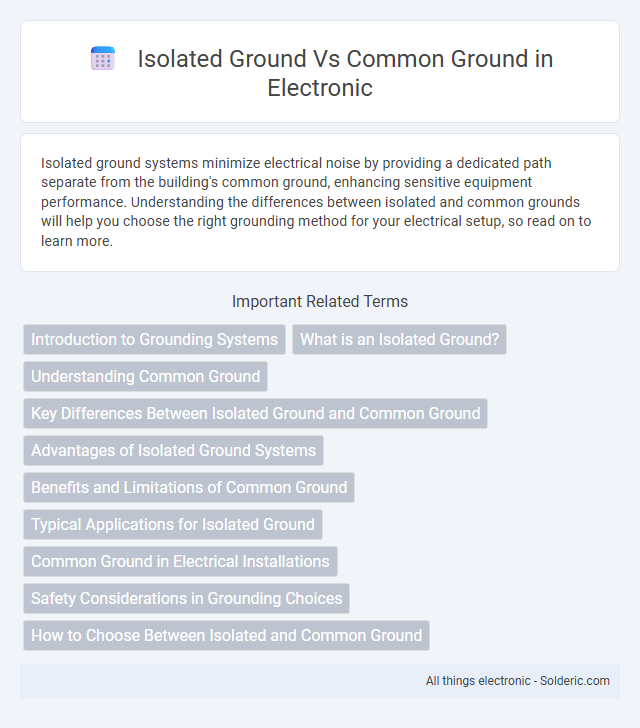Isolated ground systems minimize electrical noise by providing a dedicated path separate from the building's common ground, enhancing sensitive equipment performance. Understanding the differences between isolated and common grounds will help you choose the right grounding method for your electrical setup, so read on to learn more.
Comparison Table
| Aspect | Isolated Ground | Common Ground |
|---|---|---|
| Definition | A dedicated grounding path separated from other grounds to minimize electrical noise. | A single shared grounding path used for multiple circuits or equipment. |
| Purpose | Reduces interference and noise in sensitive electronic equipment. | Provides a basic safety ground for electrical systems. |
| Application | Used in audio systems, medical devices, and data centers. | Common in residential and general commercial electrical wiring. |
| Noise Susceptibility | Low noise due to separation from other grounds. | Higher noise risk from shared current paths. |
| Installation Complexity | More complex and costly due to separate wiring. | Simpler and cost-effective installation. |
| Safety | Enhances device performance but no significant safety advantage. | Ensures safety by fault current path. |
Introduction to Grounding Systems
Isolated ground systems use separate grounding conductors to reduce electrical noise and interference in sensitive equipment, improving signal integrity and safety. Common ground systems connect all equipment to a shared grounding point, simplifying wiring but potentially introducing noise from other devices. Effective grounding systems ensure proper fault current paths, minimize electromagnetic interference, and protect both equipment and personnel.
What is an Isolated Ground?
An isolated ground is a dedicated grounding conductor that separates sensitive electronic equipment from common electrical noise and interference found in typical grounding systems, ensuring minimal signal disturbance. This specialized grounding path is often used in medical devices, audio equipment, and precision instrumentation to maintain signal integrity and reduce electrical noise. Your equipment benefits from an isolated ground by enhancing performance and reducing the risk of malfunction caused by ground loops or electrical interference.
Understanding Common Ground
Common ground serves as a shared reference point in electrical systems, ensuring all connected devices operate with the same voltage baseline to prevent interference and signal degradation. This grounding method simplifies wiring and reduces costs by using a single return path for electrical currents, which is suitable for most residential and commercial applications. Understanding common ground helps you maintain system stability and troubleshoot grounding issues effectively.
Key Differences Between Isolated Ground and Common Ground
Isolated ground uses a dedicated grounding conductor separate from the building's main grounding system to minimize electrical noise and interference, making it essential for sensitive electronic equipment. Common ground shares the same grounding path for all electrical devices, which can introduce noise due to shared impedance and is typically used in general-purpose wiring. The key difference lies in noise mitigation; isolated ground improves signal integrity by preventing ground loop currents, whereas common ground prioritizes cost-effectiveness and simplicity in standard installations.
Advantages of Isolated Ground Systems
Isolated ground systems reduce electrical noise and interference by separating sensitive equipment grounding from standard building grounds, improving signal integrity in medical and audio-visual applications. They minimize ground loops and voltage fluctuations, enhancing equipment performance and safety in environments with critical electronic devices. This isolation also protects against transient voltages and electromagnetic interference, ensuring reliable operation of sensitive instrumentation.
Benefits and Limitations of Common Ground
Common ground wiring simplifies electrical system design by providing a single reference point for all circuits, reducing complexity and installation costs. It effectively minimizes ground loop issues in low-frequency applications but may introduce noise problems in sensitive electronic devices due to shared return paths. Understanding these limitations helps you choose the appropriate grounding method to ensure system reliability and performance.
Typical Applications for Isolated Ground
Typical applications for isolated ground include sensitive electronic equipment, such as medical devices, audio systems, and precision measurement instruments, where minimizing electrical noise and interference is critical. Isolated ground systems reduce the risk of ground loops and electrical noise, ensuring cleaner signal integrity and enhanced device performance. Your equipment benefits from improved protection against transient noise and interference in environments with complex electrical systems.
Common Ground in Electrical Installations
Common ground in electrical installations refers to a single grounding point shared by multiple circuits or systems to ensure a uniform voltage reference and reduce electrical noise. It simplifies wiring, minimizes ground loops, and enhances safety by providing a consistent path for fault currents to return to the earth. Proper implementation of common ground is crucial in residential and commercial buildings to maintain electrical system integrity and protect equipment from damage.
Safety Considerations in Grounding Choices
Isolated ground systems reduce electrical noise by separating the grounding conductor from the building's common ground, enhancing safety in sensitive electronic environments. Common ground systems provide a single, shared reference point that helps prevent voltage differences and potential shock hazards in general electrical installations. Selecting the appropriate grounding method is crucial to comply with electrical codes and mitigate risks of electrical faults and interference.
How to Choose Between Isolated and Common Ground
Choosing between isolated ground and common ground depends on the sensitivity of the electronic equipment and the noise level in the environment. Isolated ground is ideal for minimizing electrical noise and preventing ground loops in sensitive audio, medical, or communication devices, while common ground suits general-purpose applications with less stringent noise requirements. Evaluate the circuit's susceptibility to interference and grounding scheme compatibility to ensure optimal performance and safety.
Isolated ground vs Common ground Infographic

 solderic.com
solderic.com